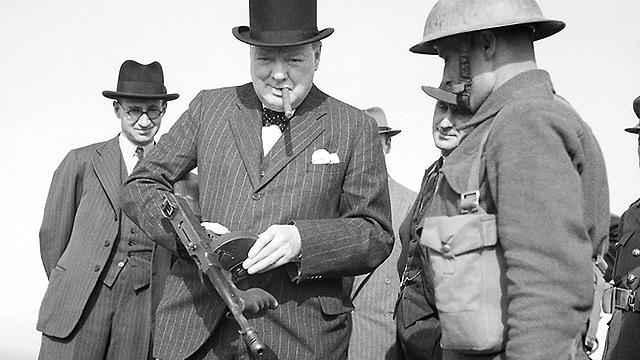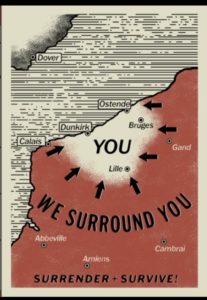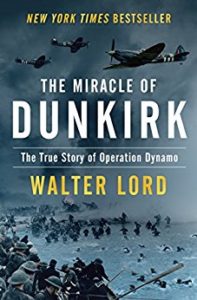We Surround You – Surrender and Survive

In the opening scene of Christopher Dolan’s Dunkirk, Nazi propaganda leaflets, thrown from German planes, reign down on a small group of British soldiers walking through a deserted French street near the beaches of Dunkirk. “We Surround You - Surrender and Survive,” the flyer instructs the soldiers, ominously implying what will happen if they don’t.
Seconds later, all but one of the six soldiers are mowed down by enemy fire. The rest of the movie is about two things: escape and survival.

Nazi propaganda flyer (Courtesy of the film Dunkirk)
By the end of the movie’s ninety-minute spectacle of heroism, sacrifice, and death, the soldier who escaped the Nazi gunfire in the opening scene returns safely to England. Grabbing a local newspaper, he reads aloud Prime Minister Winston Churchill’s speech, given on June 4, 1940: "We shall fight on the beaches, we shall fight on the landing grounds, we shall fight in the fields and in the streets, we shall fight in the hills; we shall never surrender . . .”
And that’s exactly what happens over the next five years. Britain, the only Allied country to fight from the beginning of World War II until the end, will lose nearly half a million men, women, and children during the conflict.
This past month, while visiting family and friends in the US, I spent three days in Mount Kisco, New York, where my cousin, Frances Rust, and her family live. I had never met Frances, but she graciously invited me to her home, an hour’s train ride from the City, to do research on my grandfather, Edward H. Forney.
Frances, the daughter of my grandfather's younger sister, Pauline, had boxes of letters, pictures, and documents about my grandfather, his parents, and our family, exactly what I needed for my book research. After months of emailing, talking over the phone, and making travel arrangements, I went to New York.
It was an amazing trip. During my time with Frances, we reminisced about our families, hiked on property owned by the Rockefeller's, and enjoyed wonderful meals together. As we both agreed the morning she took me to LaGuardia for my flight to Atlanta, we felt like we’d known each other for years.
On the final day of my visit we went to see the summer blockbuster movie Dunkirk. We had heard so much about the movie from friends, film critics, and journalists that we didn’t want to miss it.
As we watched the movie that afternoon in the small, quaint, all-American town of Mt. Kisco (we had walked 10 minutes from Frances’ house down tree-covered streets to the theater), I realized the movie’s hype was justified. It’s a great war movie, in that a “great” war movie is an "anti-war” movie. It graphically and disturbingly shows the terrifying randomness of life and death in a war zone. A John Wayne war movie it is not.
But Frances and I, both history buffs, had context in which to place  the movie's horrific events, something the movie doesn't provide. Christopher Nolan’s technique of giving a glimpse, or “snapshot" if you will, into an individual soldier’s traumatic combat experiences leaves out the background, timeline, strategies, and aftermath of Dunkirk, giving the moviegoer a myopic view of chaos, destruction, and death. Does this take away from the movie’s ability to put the audience in the shoes (or boots) of a British solider, sailor, or pilot? Maybe not, but it’s definitely one of the criticisms of the film.
the movie's horrific events, something the movie doesn't provide. Christopher Nolan’s technique of giving a glimpse, or “snapshot" if you will, into an individual soldier’s traumatic combat experiences leaves out the background, timeline, strategies, and aftermath of Dunkirk, giving the moviegoer a myopic view of chaos, destruction, and death. Does this take away from the movie’s ability to put the audience in the shoes (or boots) of a British solider, sailor, or pilot? Maybe not, but it’s definitely one of the criticisms of the film.
Yesterday, meanwhile, on the other side of the world, I saw the movie again. This time in Seoul. It was interesting to learn from my Korean friends that despite the international success of Dunkirk - it has grossed over 400 million dollars worldwide - the movie was not popular in South Korea. (We’ll see how it does when it opens in China, September 1, and Japan, September 9.)
The Dunkirk evacuation is almost unheard of in Korea. It’s simply not something Koreans are taught in school. This may also be true in the US these days, but because the event was part of World War II’s European theater and is so well known in the UK, the “average" American, I would venture to say, is probably more familiar with the operation than his Korean counterpart, which is understandable.
One of my friends who watched the movie with me commented after it was over, “It wasn’t what I expected." He was hoping to learn something about the historic evacuation in a sweeping saga that not only entertained but also informed. He also said the movie was hard to follow at times. I can see why. He didn't know much about Dunkirk before watching the film.
He did, however, admit he learned one thing from the movie, “I need to learn how to swim."

So, as a former history teacher always looking for ways to connect the past to the present and make history more interesting, I highly recommend Walter Lord's The Miracle of Dunkirk.
Written by a master storyteller who interviewed nearly 500 participants of the operation, the gripping account is the perfect companion guide to Nolan's film.
As Lord so eloquently states in the book's foreword, “Dunkirk remains, above all, a stirring reminder of man’s ability to rise to the occasion, to improvise, to overcome obstacles. It is, in short, a lasting monument to the unquenchable resilience of the human spirit.”


Top picture: Winston Churchill weeks after Dunkirk (Photo credit: BBC)